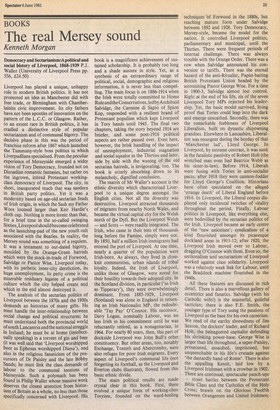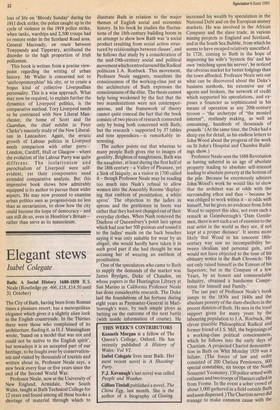BOOKS
The real Mersey sound
Kenneth Morgan
Democracy and SectarianismA political and social history of Liverpool, 1868-1939 P.J. Waller (University of Liverpool Press pp. 556, /24.50 Liverpool has played a unique, unhappy role in modern British politics. It has not promoted an idea as Manchester did with free trade, or Birmingham with Chamber',Rinke civic improvement. Its city fathers have not been apostles of innovation on the pattern of the L.C.C. or Glasgow. Rather, to an extent rare in British politics, it has cradled a distinctive style of popular sectarianism and of communal bigotry. The decisive phase in this was the period of franchise reform after 1867 which launched the Tammany-style boss politics in which Liverpudlians specialised. From the peculiar experience of Merseyside emerged a wider vision of Tory Democracy, founded not on Disraelian romantic fantasies, but rather on the ingrown, inbred Protestant workingclass democracy of Liverpool. The city, in short, inaugurated much that was modern in British party politics. Yet it was a modernity based on age-old sectarian feuds of Irish origin, in which the Sash my Father Wore loomed larger than Keir Hardie's cloth cap. Nothing is more ironic than that, for a brief time in the so-called swinging Sixties, Liverpool should become celebrated as the launching-pad of the new youth cult associated with the Beatles. In reality, the Mersey sound was something of a requiem. It was a testament to out-dated bigotry, moulded by the Orange-Green hatreds which were the stock-in-trade of Forwood, Salvidge or Pastor Wise. Liverpool today, with its pathetic inner-city dereliction, its huge unemployment, its petty crime is the miserable residuary legatee of a political culture which the city helped create and which in the end almost destroyed it.
The analysis of the sectarian politics of Liverpool between the 1870s and the 1930s demands an historian of many gifts. He must handle the inter-relationship between social change and political structures; he must understand both the provincial world of south Lancastria and the national struggle in Ireland; he must be at home (intellectually speaking) in a torrent of gin and beer (it was well said that 'Liverpool worshipped beer as Ephesus worshipped Diana'), and also in the religious fanaticism of the precursors of Dr Paisley and the late Bobby Sands; he must link the class demands of labour to the communal tensions of Merseyside. Such a polymath has been found in Philip Waller whose massive work deserves the closest attention from historians of Britain as a whole, no less than those specifically concerned with Liverpool. His book is a magnificent achievement of sustained scholarship. It is probably too long and a shade austere in style. Yet, as a synthesis of an extraordinary range of political, social, demographic and religious information, it is never less than compelling. The main focus is on 1886-1914 when the Irish were totally committed to Home Rule and the Conservatives , led by Archibald Salvidge, the Carmine di Sapio of Spion Kop, responded with a resilient brand of Protestant populism which kept Liverpool in Tory hands until 1945. The final two chapters, taking the story beyond 1914 are briefer, and some post-1918 political aspects are rather passed over. Even here, however, the brisk handling of the impact of unemployment, industrial stagnation and social squalor in the Thirties and later, side by side with the waning of the old sectarian hatreds, is invigorating, too. The book is utterly absorbing down to its melancholy, dignified conclusion.
The matrix of 1VIr Waller's account is the ethnic diversity which characterised Liverpool to a unique degree amongst the English cities. Not all the diversity was destructive. Liverpool attracted thousands of migrants from nearby North Wales, and became the virtual capital city for the Welsh north of the Dyfi. But the Liverpool Welsh — and Scots -were readily integrated. The Irish, who came in their tens of thousands long before the Famine, simply were not. By 1850, half a million'Irish immigrants had entered the port of Liverpool. At one time, nearly a quarter of the population were Irish-born. As always, they lived in closeknit communities, urban islands of tribal loyalty. Indeed, the Irish of Liverpool, unlike those of Glasgow, were noted for their hostility towards their adopted city. In the Scotland division, in particular ('as Irish as Tipperary'), they were overwhelmingly dominant. From 1885-1929, Liverpool (Scotland) was alone in England in returning an Irish Nationalist MP, the redoubtable `Tay Pay' O'Connor. His successor, Davy Logan, nominally Labour, was no less Irish in his commitment until he was reluctantly retired, as a nonagenarian, in 1964. For nearly 80 years, then, this part of dockside Liverpool was John Bull's other constituency. But other areas, too, notably Exchange, Toxteth and Abercromby, were also refuges for poor Irish migrants. Every aspect of Liverpool's communal life (not forgetting its football, as the Liverpool and Everton clubs illustrate), flowed from this basic ethnic divide.
The main political results are made crystal clear in this book. First, there evolved a unique form of working-class Toryism, founded on the ward-heeling techniques of Forwood in the 1880s, but reaching mature form under Salvidge between 1892 and 1928. Tory Democracy, Mersey-style, became the model for the nation. It controlled Liverpool politics, parliamentary and municipal, until the Thirties. There were frequent periods of internal challenge. There was always trouble with the Orange Order. There was a row when Salvidge announced his conversion to tariffs. There was the eternal hazard of the anti-Ritualist, Papist-baiting British Protestant Union headed by the astonishing Pastor George Wise. For a time in 1900-3, Salvidge almost lost control, Right at the end of his life, six of the seven Liverpool Tory MPs rejected his leadership. Yet, the basic model survived, living proof that Tories could leap into the dark and emerge unscathed. Secondly, there was the remarkable feebleness of Liverpool Liberalism, built on dynastic shipowning grandees. Elsewhere in Lancashire, Liberalism was resurgent during the heyday of that 'Manchester lad', Lloyd George. In Liverpool, by extreme contrast, it was sunk in the fatalistic passivity of Robert Holt (the wretched man even had Beatrice Webb as his sister-in-law). Before 1914, Liberals were fusing with Tories in anti-socialist pacts; after 1918 they were cannon-fodder for Lloyd George's Coalition. Historians have often speculated on the alleged `strange death' of Liberal England before 1914. In Liverpool, the Liberal corpus displayed only incidental twitches of vitality throughout the period. Finally, Labour politics in Liverpool, like everything else, were bedevilled by the sectarian politics of the Irish. Liverpool became an early centre of the 'new unionism'; syndicalism of a kind flourished amongst its picaresque dockland areas in 1911-12; after 1920, the Liverpool Irish moved over to Labour, dragging O'Connor with them. Even so, the sectionalism and sectarianism of Liverpool worked against class solidarity. Liverpool was a relatively weak link for Labour, until the Braddock machine flourished in the I 940s.
All these features are discussed in rich detail. There is also a marvellous gallery of eccentrics and fanatics. Salvidge (with his Catholic wife!) is the masterful, guileful tactician; there is also F.E. Smith, the younger type of Tory using the passions of Liverpool as the base for his own careerism. We read of the earthy shrewdness of Jim Sexton, the dockers' leader, and of Richard Holt, the beleaguered capitalist defending his shrinking power-base. George Wise is larger than life throughout, a super-Paisley, prosecuted, assaulted, imprisoned, but unquenchable in his life's crusade against 'the dastardly hand of Rome'. There is also the appalling Kensit, • laid low by a Liverpool Irishman with a crowbar in 1902. There are continual, spectacular punch-ups street battles between the Protestant Bible Class and the Catholics of the Holy Cross; brawls on the Glorious Twelfth between Orangemen and United Irishmen; loss of life on 'Bloody Sunday' during the 1911 dock strike; the police caught up in the cycle of violence in the 1919 police strike, when tanks, warships and 2,500 troops had to restore order in the Scotland Road area. General Macready, en route between Tonypandy and Tipperary, attributed the disorder to the high proportion of Irish policemen.
This book is written from a precise viewpoint regarding the writing of urban history. Mr Waller is concerned not to `anthropomorphise' his city, or to create a bogus kind of collective Liverpudlian personality. This is a wise approach. What may now be required, to explain further the dynamics of Liverpool politics, is the comparative method. Tory Liverpool needs to be contrasted with New Liberal Manchester, the home of Scott and the Guardian, the chief exhibit in Peter Clarke's masterly study of the New Liberalism in Lancashire. Again, the erratic growth of Labour politics in Liverpool needs comparison with other ports — London, Cardiff, Hull or Glasgow — where the evolution of the Labour Party was quite different. The isolationism and parochialism of Liverpool were selfevident, yet their components need extended comparative analysis. But this impressive book shows how admirably equipped is its author to pursue these wider aspects. He may now proceed to examine urban politics seen as progressivism no less than as sectarianism, to show how the city could become the hope of democracy — and can still do so, even in Heseltine's Britain — rather than serve as its mausoleum.











































 Previous page
Previous page